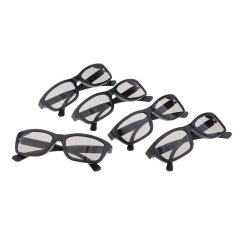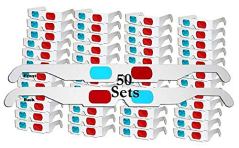BestReviews is reader-supported and may earn an affiliate commission. Details

Between its comfy design and blur-free imagery, this pair of 3D Bluetooth glasses is a must-have for watching 3D videos.
Optimized for 3D LCD projectors and most 3D TVs. Featherweight. Easily fits most faces. Comfortable fit. Reliably smooth 3D images. Up to 60 hours of battery life. Includes 2 pairs of 3D glasses.
May slightly darken the image.

A simple 5-pack of passive 3D glasses that the whole family, and maybe guests, can enjoy using together.
These will withstand lots of use if you take care of them. They're scratch-resistant and impressively sturdy for the cost. They're designed for movies and work with most 3D-equipped smart TVs.
Quite simple, and the 1 size fits all design will be too big or small for some.

This bulk purchase of 50 cardboard 3D glasses is a thrifty and solid solution for watching 3D content with guests.
Especially affordable. Includes 50 cardboard 3D glasses. Featherweight. Simple red and blue lenses. Disposable. Fits most viewers.
Study enough for 1 or 2 viewings before you should use another pair.

A 10-pack of EasiLife 3D glasses is a cheap, but surprisingly effective way to stock up on bonus 3D glasses for visitors.
Especially affordable option. Includes 10 pairs of cardboard 3D glasses. Individually wrapped. Disposable. Red and cyan lenses. Featherweight.
On the smaller side.

We recommend these products based on an intensive research process that's designed to cut through the noise and find the top products in this space. Guided by experts, we spend hours looking into the factors that matter, to bring you these selections.

Why settle for just two dimensions when you’re watching movies or playing video games? If you want an exhilarating and immersive entertainment experience, 3D technology is the way to go. However, in order for that experience to truly be the best it can be, you need the right pair of 3D glasses.
To many, the way 3D technology works can seem a little like magic. It really only involves isolating the image that each eye sees so your brain can layer those images together to add depth. The most important thing to remember is that 3D glasses are specific to the system you’re using to display or project the 3D image.

Currently, there are only three types of 3D glasses available — anaglyph, polarized, and active shutter — and each one is only compatible with a specific type of technology. In other words, you can't use one type of 3D glasses to view a different type of display.
Anaglyph: An anaglyph 3D image uses color to distinguish two superimposed images that your brain merges into one. This is a passive technology, meaning it requires no power to work. Anaglyph 3D glasses feature two lenses, each a different color — typically red and cyan, but there can be other color combinations. These are the least expensive 3D glasses (often the frames are cardboard), though more expensive models exist.
Polarized: A polarized 3D image uses a different type of polarization for each image. Correspondingly, polarized 3D glasses feature a different type of polarization in each lens to allow each eye to only view one of the superimposed images. This type of 3D glasses is also passive, but it’s preferred over anaglyph because it allows the viewer to experience 3D images in color.
Active shutter: 3D glasses with an active shutter require power in order to function. These glasses only work with special projectors that display rapidly alternating images. When the projector and the glasses are synced, the right eye is blocked while the image for the left eye is on the screen, then the left eye is blocked while the image for the right eye is on the screen. At slower speeds, the viewer can detect a flickering, but in the latest models, the flicker is so fast that the eye doesn't notice. Active shutter 3D is the best 3D system, offering a higher resolution than polarized 3D. However, it’s also the costliest.

As long as your 3D glasses use the same technology as your images, they will work. However, if you'd like to enhance your overall user experience, here are a few additional aspects to consider.
Size: The best 3D glasses are not one size fits all. If you can find glasses that offer adult and child sizes, that is advisable. This makes a difference in terms of comfort (how tight or loose the glasses feel on your head) and the size of the lenses. If you can see around the edges of your lenses while looking straight ahead, you might not have the best 3D experience.
Clip-on: Some 3D glasses, usually passive glasses, are available as lightweight clip-ons. If you already wear prescription glasses, this might be a better option for you.
Battery: Active 3D glasses need a power source, which is usually a rechargeable battery. Ideally, you want a battery that can charge in just hours but can last for months on standby.
Power-saving mode: It’s easy to forget to turn off your active glasses. You take them off after a pulse-pounding movie and set them on the coffee table. The next time you go to watch a 3D movie, you can't because the battery is dead. Fortunately, most 3D glasses have a standby mode that automatically turns on when the glasses are in use or shuts off when the sync has been lost. If you’re using active 3D glasses, this is a feature you’ll greatly appreciate.
The price brackets for 3D glasses fall pretty much in line with the type. The price ranges overlap when you purchase packs of multiple pairs. For example, a pack of four pairs of polarized 3D glasses might cost $20 or more, which would also plant it firmly in active 3D glasses territory.
Inexpensive: If you’re looking for a pair of anaglyph glasses (red and cyan), you can expect to pay between $2 and $9 each. At the lower end, the glasses are cardboard, but at the upper end, they look and feel more like sunglasses.
Mid-range: If you need polarized glasses, the kind that will work at an IMAX theater, those start at around $9 for clip-on lenses but can cost up to $15 for a stylish pair.
Expensive: For active shutter 3D glasses, you can expect to pay between $15 and $25.
When you get nauseated watching a 3D movie or playing a 3D video game, it's called cybersickness. It's a real thing, a “sensory mismatch” like motion sickness, and it can ruin your enjoyment of the 3D experience.
When you’re sitting still watching a movie or playing a game that’s too real, it sends mixed signals to your brain. Your eyes perceive motion, but the fluid in your inner ears says no motion is happening, so your brain responds with a feeling of nausea. The more complex and detailed the image, the sooner the feeling of nausea occurs in individuals who are prone to cybersickness (women more often than men). It’s believed that the brain interprets the inconsistency as poison and begins the process of trying to expel the toxin from your system, hence the nausea. Here are some tips to combat cybersickness:

Q. Is it safe to wear 3D glasses?
A. Yes. Although some individuals may experience unpleasant side effects, current studies conclude that wearing 3D glasses does not cause any permanent damage to your eyes. Even though there is no concrete evidence, some members of the medical community recommend that children younger than six not wear 3D glasses because that is a pivotal time in vision development.
Q. What possible side effects could I experience from wearing 3D glasses?
A. Because the eye focuses differently when wearing 3D glasses, it can bring to light minor vision problems that go unnoticed in normal day-to-day living. Because of this, certain individuals may experience fatigue, soreness, and headaches when wearing 3D glasses. These aren’t typically serious issues and will quickly dissipate after removing the glasses.
Q. Can I get an eye infection from wearing the 3D glasses you get at movie theaters?
A. The 3D glasses you wear in movie theaters have gone through a washing process, so the chances of getting an infection are slim. However, if you’re the type who likes certainty over probability when it comes to infections, that’s another case for owning your own pair of 3D glasses. You just need to be sure that your glasses are the same type as the ones being used in the theater, which are likely, but not always, polarized 3D glasses.
Get emails you’ll love.
Learn about the products you’re wondering if you should buy and get advice on using your latest purchases.
